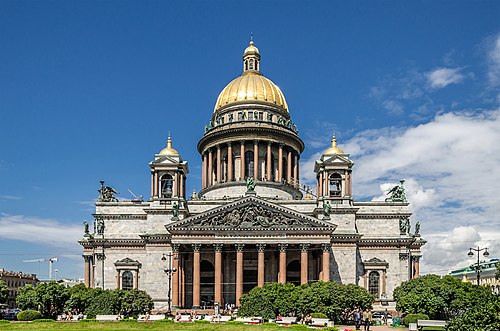
St. Isaac’s Cathedral Russia in St. Petersburg is renowned for its grand dome, intricate mosaics, and rich interior details. Among its many treasures, the stained-glass windows stand out as a rare and luminous feature. Therefore, infusing the solemn grandeur of the cathedral with vibrant color and light. Unlike traditional Orthodox churches, which typically rely more on mosaics and frescoes, St. Isaac’s incorporates a monumental stained-glass composition. This concept feels both unusual and deeply symbolic.
A Rare Feature in Orthodox Architecture
Stained glass is not a typical element in Russian Orthodox churches, where iconography and mosaics dominate. However, the 19th-century architects and artists who shaped St. Isaac’s Cathedral wanted to combine traditional Orthodox design with elements of Western European cathedral art. This blend created a unique atmosphere, allowing the stained-glass works to act as both spiritual and artistic focal points within the vast interior.
The Central Stained-Glass Masterpiece
The most striking stained-glass window is located in the main altar area. Standing over 10 meters high, it depicts the image of the Resurrected Christ, bathed in radiant light and framed by rich ornamental details. Christ is shown with arms outstretched, a gesture that conveys both triumph and blessing. The window’s placement allows natural light to illuminate the figure, giving worshippers the sense that the divine presence is entering the cathedral itself.
This window was created in Munich in the mid-19th century, crafted with an attention to detail and color that elevates it beyond mere decoration. The deep reds, glowing blues, and shimmering gold tones shift throughout the day. Therefore, depending on the angle of sunlight, giving the scene a dynamic, almost living quality.
Artistic Symbolism and Spiritual Impact
The stained-glass image of Christ carries profound symbolism. In Orthodox belief, the Resurrection is the cornerstone of faith, and this depiction reinforces that truth visually and spiritually. While icons and mosaics traditionally serve this role, the stained glass here enhances the worship experience by drawing the eye toward light itself, a metaphor for divine truth and salvation.
Visitors often remark on the contrast between the cathedral’s heavy granite columns, gilded surfaces, and the delicate, almost ethereal glow of the glass. This interplay between weight and lightness reflects the theological idea of heaven’s presence breaking through the earthly realm.
Integration with the Cathedral’s Interior
The stained-glass window does not stand alone but integrates into the cathedral’s broader artistic program. Around it are mosaics of saints, apostles, and biblical scenes, all designed to harmonize with the central figure of Christ. The stained glass acts as a focal point, drawing worshippers’ attention during services and framing the altar with divine radiance.
This blending of stained glass with mosaics was highly innovative for its time. Hence, bridging Eastern Orthodox traditions with Western artistic practices. It marked St. Isaac’s as not just a house of worship. But this is also a statement of Russia’s cultural openness and artistic ambition in the 19th century.
An Enduring Legacy – St. Isaac’s Cathedral Russia
Today, the stained-glass windows of St. Isaac’s Cathedral remain one of its most memorable features. Beyond their beauty, they represent a fusion of traditions, a bold artistic choice, and a powerful spiritual symbol. For visitors, standing before the glowing figure of the Resurrected Christ offers both an aesthetic wonder and a moment of profound reflection. Hence, an encounter with art that elevates the soul as much as it pleases the eye.
